Competitive Magic is an unbelievably complex game. I’ve said it before, but I’ll reiterate: no matter how complex you think Magic is, it is more complex than that. Everyone has theories and advice to give on how to be more successful at it, but the theories we have today are still very primitive in the face of the vast complexity of the game. We still have a long way to go.
Toward that end, I hope we can first agree that the most important unit of success in competitive Magic is the tournament; after all, tournament finishes are the measuring stick by which we evaluate every top-level player.
You come into a tournament with a specific goal, usually to win it. In certain rare cases you are aiming to go, say, 2-0-drop, so that you can qualify for some more important event on rating, but usually the goal is to win the whole shebang. You typically accomplish this goal by winning matches, although often it makes more sense to intentionally draw a match (thus securing yourself a position in Top 8, or perhaps eliminating some measure of risk from your prize payout if you are already out of contention) and sometimes even to concede a match, in order to advance your goals for the tournament as a whole. Other times you may concede to a friend, but rarely are you doing that in order to further your own success as a Magic player.
Almost all practical theories – as opposed to the kind that simply seek to describe a phenomenon without trying to help guide your actions – are shortcuts meant to lead you to tournament success.
Some theories are shortcuts for playtesting or for truly comprehensive understanding; you certainly don’t need to know The Philosophy of Fire to learn how to play a Red deck properly. For one thing, a friendly neighborhood Redhead like Pat Sullivan or Dan Paskins (or, heck, Joe from the card shop) might just sit you down and explain the merits and mathematics of heating up your opponent’s face without ever putting a name to what they’re telling you. For another, you might just figure these things out intuitively from playing Red over and over. After all, it’s not like you have to know the theory to be able to profit from its implications.
Some time ago, Adrian Sullivan wrote a tragically under-appreciated article comparing the merits of following Magic theory versus following your own observations when trying to maximize the odds that you will achieve your goals for a given tournament. He made an especially good point in the forums of that article:
The knowledge we get from actual experience usually trumps everything.
Adrian Sullivan
If a theory tells you that one thing is true, but you keep experiencing the exact opposite in practice, it’s more likely that the theory is wrong than that reality is just messing with you.
The beauty of theory is that if you don’t have a Dan or a Pat or a Joe handy to impart wisdom, you can save yourself an awful lot of trial and error by subscribing to a shortcut that will help you along the road to a complete understanding of some part of the game. You read the above article on The Philosophy of Fire, and you learn some principles that (hopefully!) help you better understand Red decks.
As Adrian explains, we all use a mix of theory and experience to guide our decisions. Where we have no experience, we substitute theory. When we don’t have time to test every possibility, theory fills in the gaps for us. It’s a beautiful thing.
Speaking of Paskins, he once wrote one of the most powerful theory articles of all time on the subject of something he called The Fear. Much of what he means by The Fear is the fear of being embarrassed.
When you decline to play a Red deck because the opponent might embarrass you by shutting down your whole deck with a Circle of Protection: Red, you are giving in to the Fear, often to your own detriment. An impartial cost-benefit analysis – or even just some playtesting against the feared CoP – will often reveal that Red decks can overcome such hosers, but many potential Red mages are too Fearful that they will waste their time (and their playtest partners’) pursuing a lost cause, and so they give up before they might even begin.
This instinct is understandable, of course; it’s embarrassing to raise your voice against conventional wisdom only to discover the conventional wisdom had it right and you had it wrong. Still, no matter how painful or embarrassing it might be to stand up and question things, failing to challenge conventional wisdom will inevitably lead to missed opportunities in a game too complex for conventional wisdom to ever cover it all.
The Profitable Exception
We all know that you should choose to play first in Magic. There’s a formality step at the beginning of each game where you may be given the option to draw first, but it’s a red herring. It’s a “skill tester,” meant to lead you astray if you answer incorrectly. Pro Tour legends from Kai Budde to Jon Finkel to modern masterminds like Gabriel Nassif and Luis Scott-Vargas have all chosen to play first innumerable times in their careers, and they have made their marks on Magic in part thanks to this wise decision.
What I have just told you is a theory of mine. I sounded pretty confident when I said it, didn’t I? In fact, it might not have sounded like so much a theory so much as it did a given. Look, everyone is following this rule, from the Ancient Masters to the New Gods of Magic. Why wouldn’t you do it, too?
In fairness, there’s a good chance you already are doing it. Many competitive Magicians will go their entire careers without uttering the phrase “I’ll draw first,” and most of the time, this is probably a fine choice.
There are times when even Pro Tour Champions will go against the grain of this theory, and correctly so. In the right circumstances, you actually increase your chance of success by going against it.
Profitable exceptions to theories are ubiquitous in Magic; most theories are, at best, Most Of The Time advice. I have yet to see a piece of Magic advice that applies all the time, with no exceptions, unless it is so broad as to be useless – some approximation of “I advise you to win!”
And yet, sad to say, most theories are presented in the way I just did: with the utmost of confidence, citing case studies in which the theory led its followers to fame and fortune, and with the briefest of lip service given to those critical exceptions that acknowledge the times when following the theory will lead you astray.
Aforementioned PT Master Louis Scott-Vargas recently wrote an article blasting the entire archetype of Midrange as “terrible.” His complaints included the fact that midrange decks water down their aggressive game against control decks with controllish removal spells like Terror and Wrath of God, that they play substandard aggressive creatures like Loxodon Hierarch for the sake of defeating beatdown decks, and that they play awful-against-beatdown disruption cards for the sake of beating control. LSV asserts that midrange decks seek to do everything and end up doing nothing well, and advises his readers to avoid playing them altogether.
His criticisms are all valid. Indeed, it might be true that most of the time one would be better-served to avoid midrange decks on these grounds.
Most of the time, that is.
However, just seventy days before the publishing of this article, a certain well-known Magic player ignored LSV’s advice and played a midrange deck – in fact, a midrange deck embodying several of the exact cards he cited as examples of what was wrong with midrange – to a second-place finish at Pro Tour: Kyoto. In fact, the majority of the decks in the Top Eight of that Pro Tour were midrange. The environment happened to be supportive of midrange strategies, and many who acknowledged that fact profited from it. It was very much to their benefit that they did not practice the Don’t Play Midrange theory.
No midrange player at that tournament earned more money from this profitable exception to LSV’s rule than LSV himself, who took second place with a B/W Midrange deck. He later explained that the deck suited him – despite being midrange – because it played the aggressor in almost every matchup, muting the drawback of the “lack of focus” he cited as the strategy’s main problem. Unfortunately, as with so many theory pieces, this critical exception went unexplained in the article proper.
Why is this so bad?
Off A Cliff
A shortcut that always gets you to your destination quicker than your normal route is a great shortcut!
A shortcut that gets you there quicker half the time, and half the time sends you off a cliff, is an awful shortcut.
As shortcuts, most worthwhile Magic theories fall somewhere in between these two cases. Most of the time, following a good theory will lead you to the correct decision more quickly than you could have arrived at that decision through brute force (trial and error, playtesting, practice, and the like).
Some of the time, though, they will lead you off a cliff. It would be nice if they didn’t, but unfortunately we still have yet to see any useful perfect theories in Magic.
Had LSV followed his own advice regarding midrange – unless he miraculously managed to duplicate his finish or to win the Pro Tour with some other deck – he would have sacrificed some part of $20,000, twenty Pro Points, a second-place finish at a Pro Tour, and a first-place finish at the end of the Swiss at said PT. In terms of a Magic Tournament, that is about as close a practical example of a theory driving you off a cliff as you can get.
The examples are not always as clear-cut as this, though. How often have you been this close to Top 8, or this close to winning the tournament, but one wrong decision along the way tripped you up? Competitive Magic is very often a game that does not forgive mistakes, and if a theory should lead you astray even once – especially in something as fundamental to your chances of success as deckbuilding or deck selection – it can easily mean the premature end of the tournament for you.
When learning a new language, you start with some broad rules to help you get going. These will help you get started, even if they will lead you to be incorrect in some cases. To truly master a language, you cannot stop there – for every language has its grammatical peculiarities. You must seek out exceptions to the rules you have learned, either by endeavoring to learn them from others (if you’re really lucky, the person who offered the rules in the first place will go into exceptions as well) or by getting out there and practicing, exposing yourself to the potential embarrassment of making mistakes so that you can learn from them.
To get the most out of Magic theories, then, you must not only understand how to apply them, but also – critically – how to recognize when they are about to lead you off a cliff, so that you can selectively ignore them in those cases. The more exceptions you can identify and understand, the closer you will be to realizing the complete truth.
The Plateau of Mediocrity
There’s a school of writing that believes everything I’ve just written is a detriment to the community. Some believe it’s best to offer readers only a shortcut that will take them off a cliff a third of the time, and nothing more, because the alternative might be worse. The concern is that by offering exceptions as well, readers will think the theory is too shaky to be valuable, or too confusing to be worth their time, and will end up even worse than flying off a cliff one third of the time.
Obviously, I don’t buy it. I give StarCityGames.com readers more credit than that.
Maybe there are some players out there for whom this is true – they would be too skeptical or confused by the combination of a theory and a discussion of its exceptions to get any benefit out of it. But even for those theoretical players, subscribing wholesale to a variety of theories will do nothing more than lead them to a plateau of mediocrity. There will forever be a smattering of holes in their game, exceptions to rules they have no idea they’re stumbling over, and until they set out in search of those exceptions, they will never – to use a Patrick Chapin term – take their game to the Next Level.
Worse, as human beings, it is very difficult to unlearn what we have learned. Once we have gotten it through our heads that we should Always Play First, and had it reinforced by losing games on the draw that we know we would have won on the play, it becomes deeply entrenched in our minds. Beyond a certain point, it becomes almost unthinkable to draw first, especially when we are subscribing a theory that has been verified by your own experience. We will be an underdog in Red mirrors against that crazy Dave Price and his tendency to draw first, but we may never realize why.
After all, when you are following the Play First rule, you have confidence on your side. You have that paragraph full of confident-sounding language and Pro Tour namedrops on your side. Maybe you even have a whole article backing you up. You’ve reaped the benefits of following the theory many times, and seen your friends do the same. You’ve seen what happens when players draw first and lose because of it, and it’s ugly. Why tempt fate?
Knowing all this, with so much evidence supporting the theory, there’s an inherent fear associated with challenging it once you have accepted it with such open arms. It’s the fear of embarrassment, just like Paskins talked about. You fear that after your friends indulge you in twenty playtest games where you draw first each time, you are going to get rolled, and you are going to look like an idiot for wasting everyone’s time trying to find an exception to a theory that might as well be as universally accepted as gravity.
We all have this fear at some level. We must suppress it.
If we are to identify these profitable exceptions, to truly get the most out of the theories that save us so much playtesting time, to ever have a shot at mastering this game, we must suppress the urge to remain incurious about advice we know cannot be complete in a game as complex as Magic.
The Best Advice I Have to Give
Question advice. Challenge theories. Seek out profitable exceptions.
Grow as a player along the way.
Best of luck to you all!
Richard Feldman
Team :S
lcd_cow@yahoo.com
Bonus Section: Magic Across America
Several years ago, I took a road trip from St. Louis to Los Angeles and back with my fellow roomies Tom Mooney and Paul Bender. As this trip involved passing through quite the diverse array of terrain, we decided to take pictures corresponding to each basic land type along the way. I somehow never got around to posting them at the time of the trip, but better late than never!
California Island
Part of our trip involved a boat ride from Long Beach Harbor over to Catalina Island, just off the coast of CA. It ended up being one of the more expensive parts of our trip, but Catalina is a fun place to hike around and explore. It’s got a very American harbor town called Avalon where people commonly drive golf carts around because all their needs are so centralized, but then again the price of gasoline was roughly double what it was back in St. Louis. I’d recommend it, if you’re ever in the area.
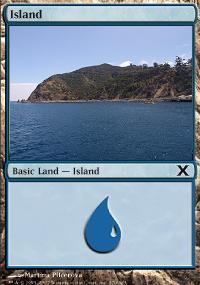
Texas Forest
Seriously! This is from Texas! We had no idea the Lone Star State had so much greenery, but as we drove through Eastern Texas towards Louisiana, we saw the most lush forestry of the entire trip. It wasn’t just one patch of it either – we’re talking hours of driving surrounded by solid forest just like this. In Texas!
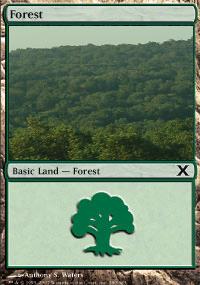
Arizona Mountain
We probably could have gotten a better mountain picture out of Utah, but unfortunately we passed through there at night. Crossing Utah at night, by the way, is a completely miserable drive. All the interesting things are too far away to make out in pitch blackness, and then you see signs like “Dust Storm Speed Limit 30mph” followed by “No services for next 100 miles.” Not awesome. Oh, and then you get pulled over for speeding.
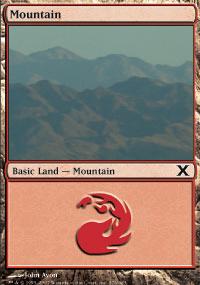
Louisiana Swamp
We weren’t feeling adventurous enough to go far enough off the highway to get up-close and personal with the true Cajun Swamp Experience, but this did let us arrive at (pre-Katrina) New Orleans earlier, allowing us to get a head start on some Bourbon Street Good Times.
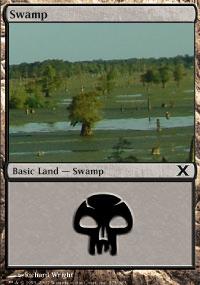
Oklahoma Plains
I am somewhat iffy on whether or not this picture was taken in Oklahoma. I wouldn’t swear to it, but I feel bad that I can’t remember because it is an awesome shot. (Which probably means Paul or Tom took it.) That trail of dust in the background was kicked up by a pickup truck barreling down a dirt road in the distance.
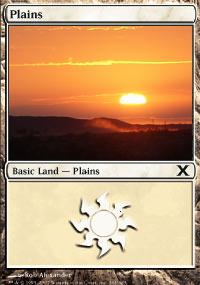
If you are ever planning to embark on a road trip, I absolutely endorse doing this. Island and Swamp are the toughest to get, but you can get creative – really, it doesn’t have to be a real Island or a real Swamp, so long as it looks like one – and it definitely adds a fun twist to a trip.
So if you think you’re game to hunt down photos of all five basic land types, I suggest you go for it! If nothing else, you will end up with some good times to think back on later.
Take ‘er easy, Dudes.

